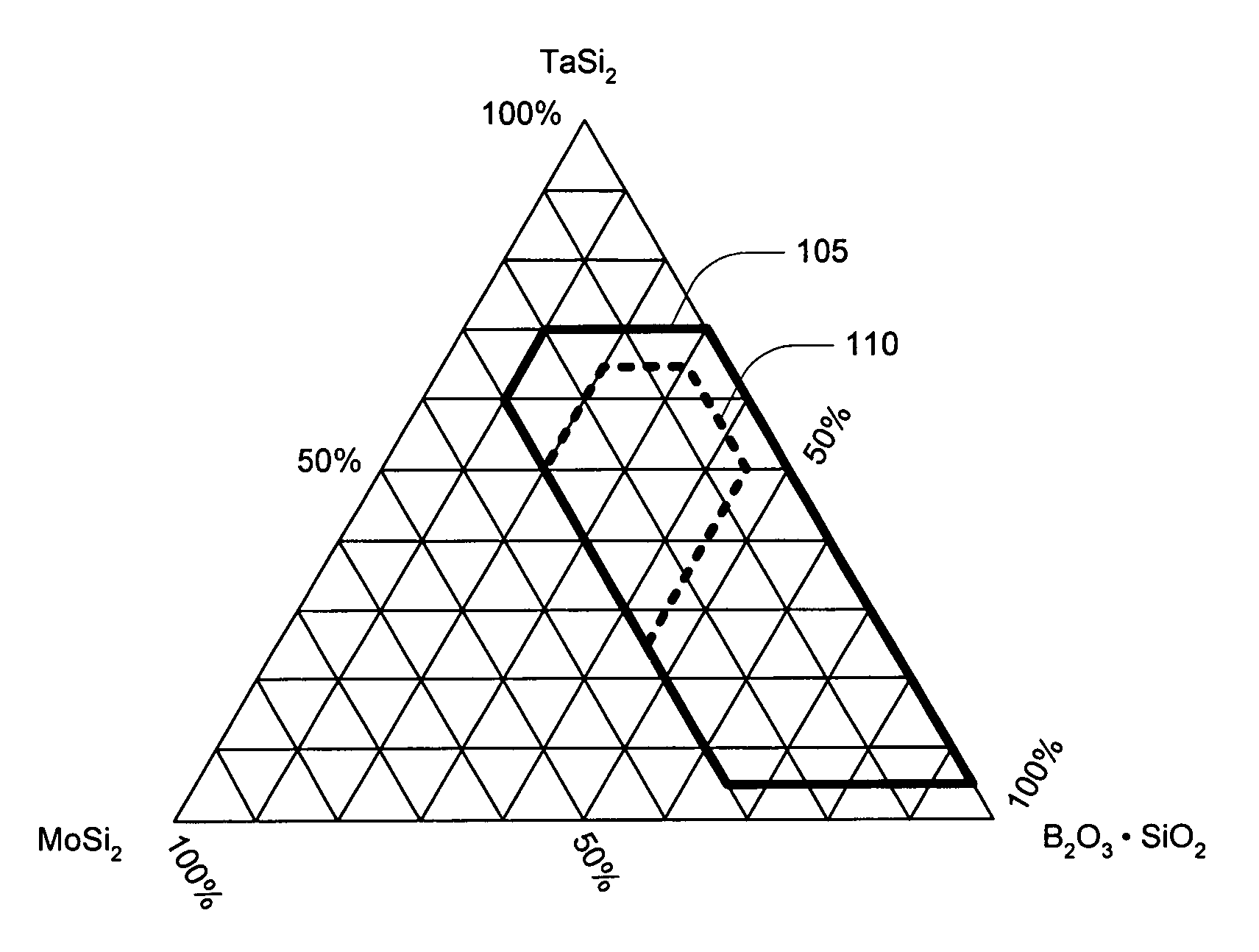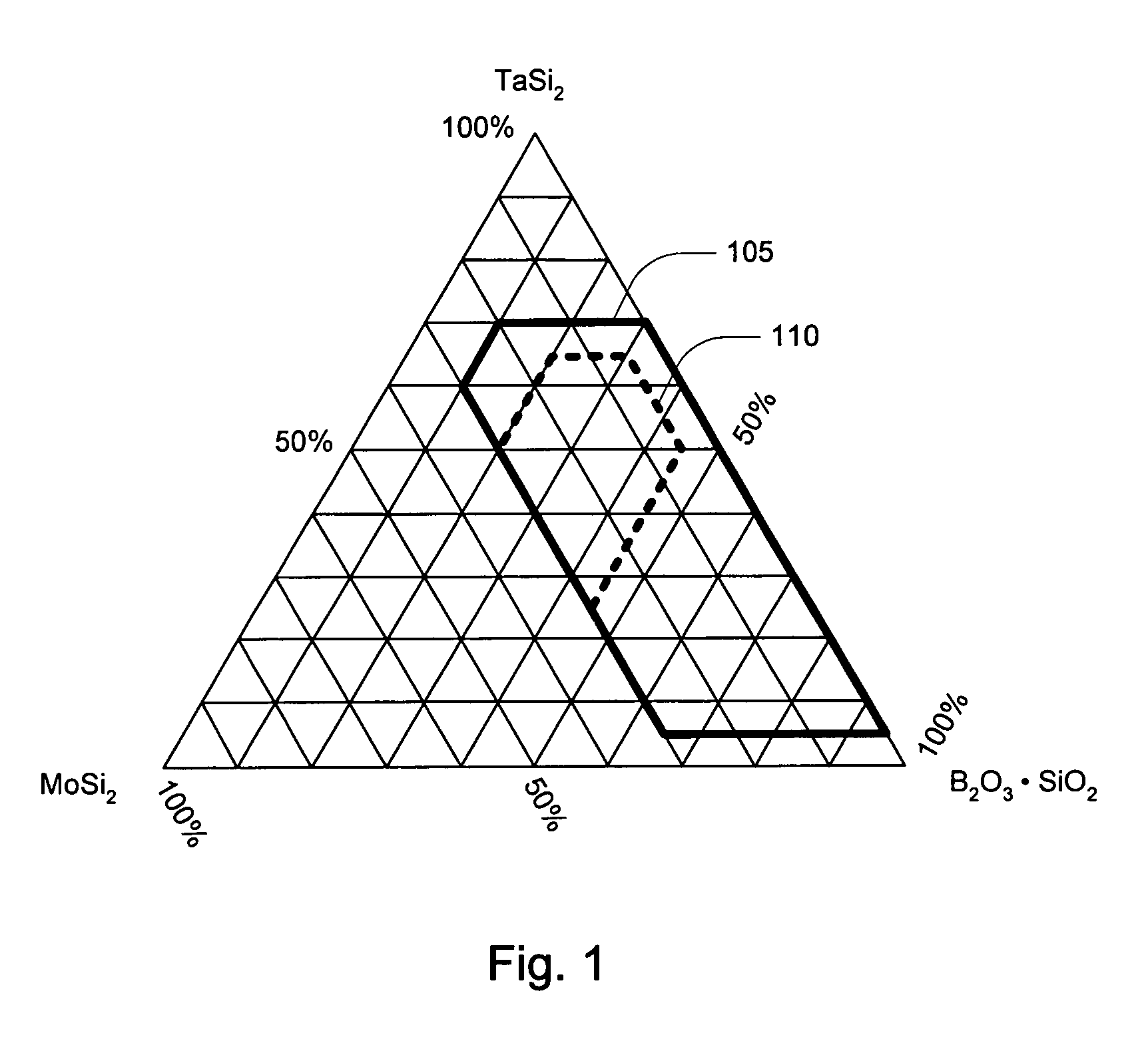High efficiency tantalum-based ceramic composite structures
a composite structure, high-efficiency technology, applied in the direction of cosmonautic safety/emergency devices, water-setting substance layered products, synthetic resin layered products, etc., can solve the problems of loss of the vehicle during earth entry, high cost, and long lead time, so as to increase the capability of a tufi-like thermal protection system, reduce the cost of system installation, and reduce the effect of oxidation
- Summary
- Abstract
- Description
- Claims
- Application Information
AI Technical Summary
Benefits of technology
Problems solved by technology
Method used
Image
Examples
example 1
[0037]For one embodiment, a composite insulating structure substantially impervious to hot gas penetration was prepared by mixing 35% tantalum disilicide with 20% molybdenum disilicide, 2.5% silicon hexaboride and 52.5% borosilicate glass. The borosilicate glass may contain from about 1% to about 10% boron oxide, but is preferably approximately 94.25% silicon dioxide and 5.75% boron oxide. All of the components were ball milled for 65 hours in an alcohol medium at 70% solids. FIG. 6 is a graph of the approximate particle size distribution measured after one such milling. After milling, the components were diluted to 25% solids prior to spraying on a substrate, e.g., AETB-40 / 12, with a sub-layer applied. The sub-layer was composed of 55% molybdenum disilicide, 2.5% silicon hexaboride and 42.5% borosilicate glass. All of the components of the sub-layer were ball milled for 65 hours in an alcohol medium at 70% solids and diluted to 25% solids prior to application. The sub-layer compris...
example 2
[0038]For another embodiment, a composite insulating structure substantially impervious to hot gas penetration was prepared by mixing 15% molybdenum disilicide with 60% tantalum disilicide, 2.5% silicon hexaboride and 22.5% borosilicate glass. All of the components were ball milled for 65 hours in an alcohol medium at 70% solids prior to spraying on a carbon preform with a sub-layer applied. The sub-layer was composed of 20% molybdenum disilicide, 2.5% silicon hexaboride and 77.5% borosilicate glass. All of the components of the sub-layer were ball milled for 65 hours in an alcohol medium at 70% solids and diluted to 25% solids prior to application. The sub-layer comprised 40% by weight of the total surface treatment. The structure was fired at 2400° F. (1315° C.) for 10 minutes and successfully tested at above 3800° F. (2095° C.) for one minute in a high-energy arc jet flow. FIG. 7 is a photomicrograph showing the particulate nature of the insulating structure after arc jet exposur...
example 3
[0039]For yet another embodiment, a composite insulating structure substantially impervious to hot gas penetration was prepared by mixing 50% tantalum disilicide, 5% silicon hexaboride and 45% borosilicate glass. All of the components were ball milled for 65 hours in an alcohol medium at 70% solids prior to spraying on an AETB-40 / 12 substrate without a sub-layer applied. It was fired at 2225° F. (1220° C.) for 90 minutes and successfully tested at about 2900° F. (1595° C.) with observable foaming.
PUM
| Property | Measurement | Unit |
|---|---|---|
| temperatures | aaaaa | aaaaa |
| depth | aaaaa | aaaaa |
| particle size | aaaaa | aaaaa |
Abstract
Description
Claims
Application Information
 Login to View More
Login to View More - R&D
- Intellectual Property
- Life Sciences
- Materials
- Tech Scout
- Unparalleled Data Quality
- Higher Quality Content
- 60% Fewer Hallucinations
Browse by: Latest US Patents, China's latest patents, Technical Efficacy Thesaurus, Application Domain, Technology Topic, Popular Technical Reports.
© 2025 PatSnap. All rights reserved.Legal|Privacy policy|Modern Slavery Act Transparency Statement|Sitemap|About US| Contact US: help@patsnap.com



